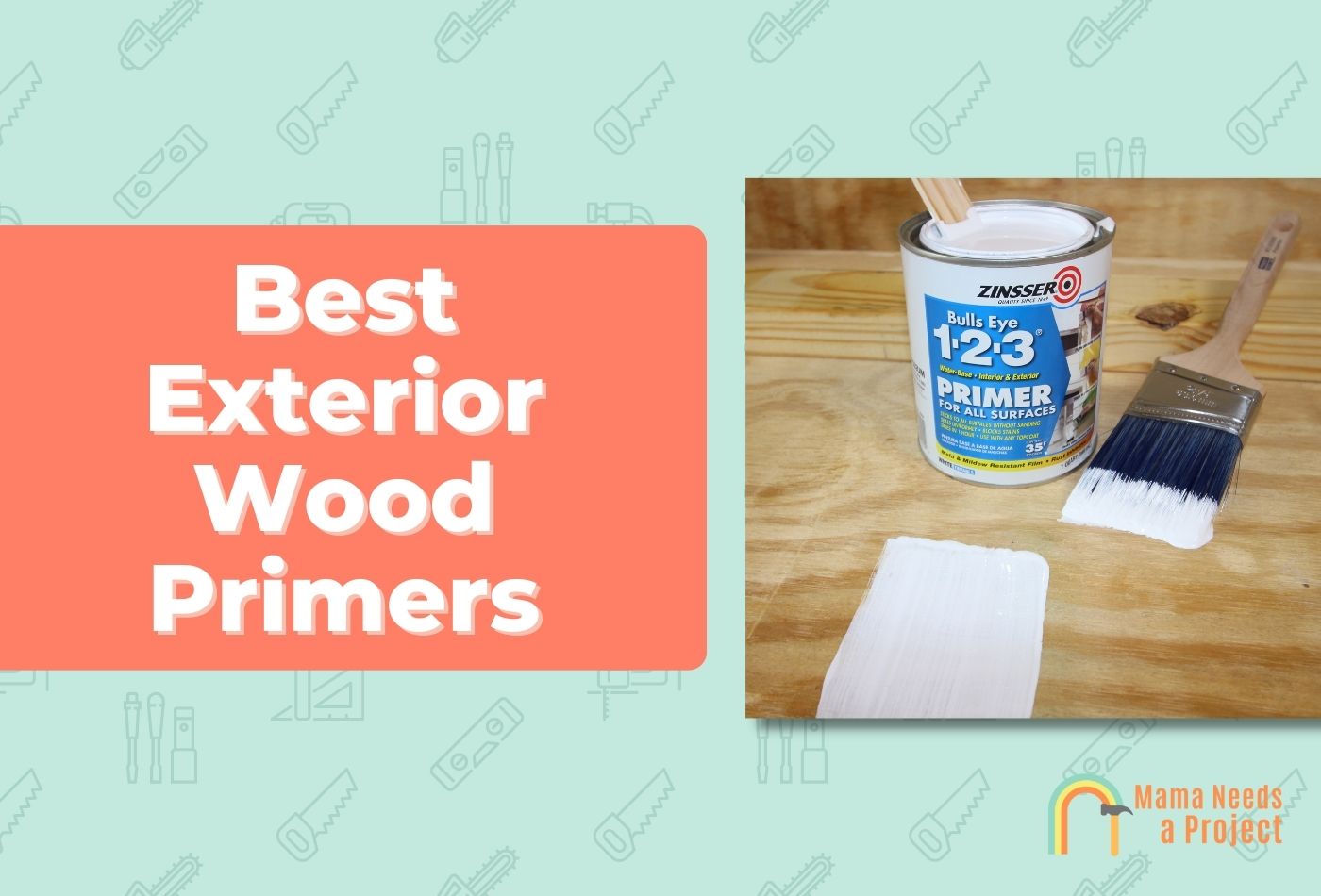5 Best Exterior Wood Primers (RANKED!)
Nobody would dispute that putting down primer is an essential part of the paining process, but which is the best primer for exterior wood?
I’ve used many different primers over the years on both interior and exterior surfaces to help you find which are best and will yield the best paint job.
In this guide, I’ll compare some of the best wood primers available to help you find the product that’ll be perfect for your next project. Let’s dig in!
In a hurry? KILZ Premium High-Hide Interior/Exterior Primer/Sealer is the best exterior paint primer because it’s durable, stain- and imperfection-blocking, versatile, easy to use, less toxic, and affordable when measured against competing products.
Best Exterior Wood Primers
- #1 Best Overall – KILZ Premium High-Hide Interior/Exterior Primer/Sealer
- Best Quality – Zinsser Bulls Eye 1-2-3 Primer
- Best Value – INSL-X Prime All Primer
- Best Exterior Primer for Old Wood – KILZ 2 All Purpose Primer
- Best Exterior Primer for Peeling Paint – KILZ Adhesion Exterior Primer
1. KILZ Premium High-Hide Interior/Exterior Primer/Sealer – Best Overall
- Made in United States
KILZ Premium High-Hide Interior/Exterior Primer/Sealer is the best exterior wood primer because it blocks out stains and other imperfections, helps to ensure a uniform finish, contains a minimal amount of volatile organic compounds (VOC), and works both indoors and outdoors thanks to its unmatched durability.
This white, matte primer is water-based (latex) and therefore removable with soapy warm water.
One quart (32 fl oz) can cover 300-400 sq ft, and it can be brushed, rolled, or sprayed on – all of which are easy to apply.
Unlike other primers, specifically oil-based versions, this primer doesn’t have a high amount of volatile organic compounds (<5 g/L VOC, excluding colorants), so it’s much less toxic, which I’m a fan of.
It does, however, have mildewcide to prevent mold and mildew growth.
It takes an hour for this latex primer to dry on a surface that was bare beforehand, but only a half hour if applied to a pre-existing coat of primer.
What I Liked:
- Quickly forms a durable seal that keeps out moisture and prevents mold growth.
- Great for changing paint colors since it’s white with a matte sheen.
- Minimal amount of VOC means less toxicity and no odor.
- Can be used indoors and outdoors since it works on most surface materials.
What I Didn’t Like:
- The surface must be free of dust, chalk, grease, etc. for this primer to be effective.
- Applying this primer with a brush can be challenging since it’s so thin.
My Thoughts:
Simply put, you can’t go wrong with KILZ Premium High-Hide Interior/Exterior Primer/Sealer. This primer can be applied to all kinds of surfaces both indoors and outdoors, and since it’s latex-based it contains a minimal amount of VOC. Plus, it dries quickly, promotes paint adhesion, and virtually blocks out all stains and imperfections that commonly deface wood surfaces. The only downside is it needs to be applied to a perfectly prepped surface to be effective, but that’s not such a big deal when you consider all this primer has to offer.
Other Stores
2. Zinsser Bulls Eye 1-2-3 Primer – Best Quality
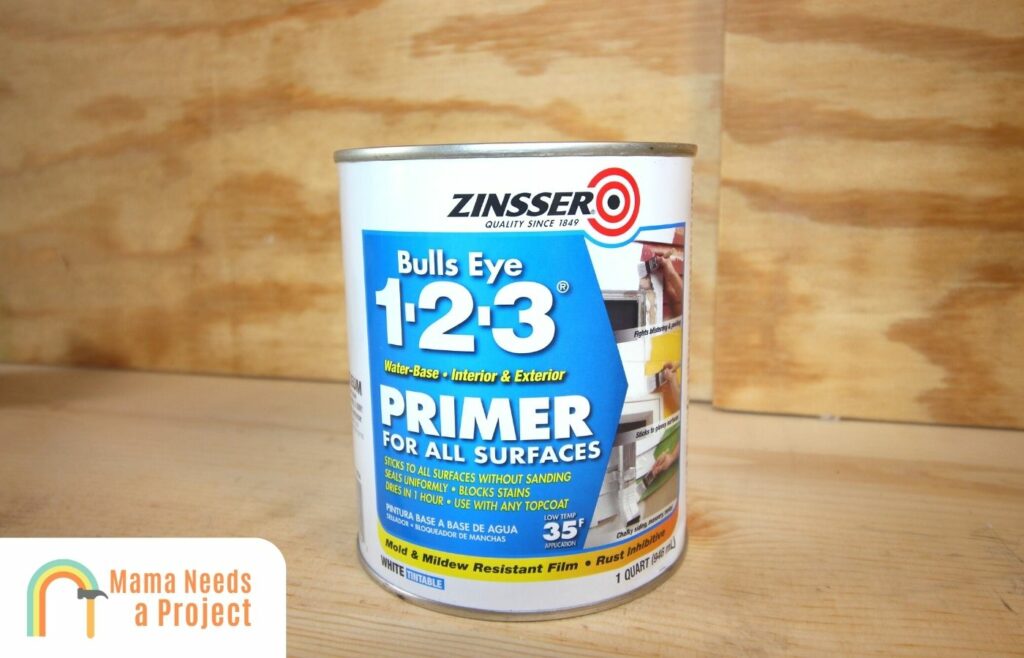
- Designed for interior & exterior use
- Binds moderately chalky surfaces
- Sticks to glossy surfaces
When it comes to blocking out stains, previous paints, and surface imperfections, Zinsser Bulls Eye 1-2-3 Primer is even better than the previous product, and a few other qualities make it an attractive purchase.
Another all-white, latex primer with a matte sheen, it comes in a 32 fl oz can and covers 87-112 sq ft.
It’s moisture-, mold-, and rust-resistant thanks to a handful of ingredients and the process by which it’s made, and it can be rolled, brushed, wiped, or sprayed on.
Its water-based composition also ensures it’s self-leveling and able to adhere to the surface it’s applied to without sanding.
This primer will usually dry in about 35 minutes, and after an hour of drying time it’ll be ready for the first coat of paint.
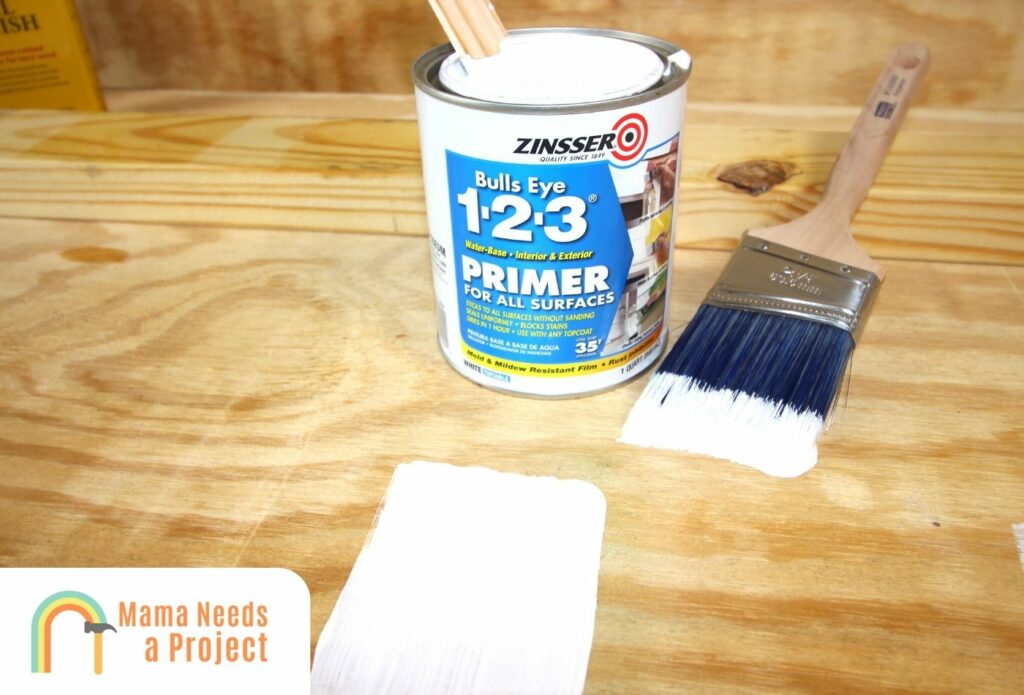
Finally, it can dry at temperatures as low as 35°F, and it comes with a warranty (that’s really a money-back satisfaction guarantee) – which is nice.
What I Liked:
- It’s cost-effective since it can be used on all common surface materials.
- It’s time-saving since you don’t have to sand before using it.
- It’s versatile since it works with both water- and oil-based paints.
- It doesn’t emit harsh, toxic fumes while drying since a minimal amount of VOC are used.
What I Didn’t Like:
- Max coverage area is smaller when compared to other primers.
- Not the best at blocking out pet odors or smoke.
My Thoughts:
All things considered, Zinsser Bulls Eye 1-2-3 Primer is a fantastic wood primer that’s capable of producing top-notch results for a reasonable price. In terms of ability to block stains and surface imperfections, this water-based primer is superior to all others on this list. Plus, it can be used on both porous and non-porous surfaces, and its composition ensures its not only durable but less toxic than competing products. If only it covered more space and blocked certain smells, it’d be at the top of this list for sure.
Other Stores
3. INSL-X Prime All Primer – Best Value
- 100% acrylic primer that provides strong sealing properties to a variety of interior & exterior surfaces
- Easy to apply
- Powerful adhesion and stain blocking properties
INSL-X Prime All Prime is a capable acrylic-latex primer that can cover a substantial area, and it’s more affordable when compared to exterior wood primers of similar quality.
Its white with a flat sheen, and 32 fl oz can cover 400-500 sq ft.
A stain-blocking primer, it’s designed to prevent bleed-through, no matter the material it’s used on.
Its made with mildewcide to prevent mold and mildew growth, and thanks to its composition it doesn’t splatter during application.
This primer can be used on interior and exterior surfaces, and it can be painted over with latex or oil paint.
Like most primers, it can be sprayed, rolled, or brushed on, and since it’s latex-based it has minimal VOCs and dries quickly (1 hour).
Lastly, it can be removed with warm, soapy water making it easy to clean up.
What I Liked:
- Cost-effective as it’s relatively cheap, able to cover a wide area, and applicable to numerous materials.
- Composition ensures both latex- and oil-based paints can adhere to it.
- Can be applied to both vertical and horizontal surfaces since it’s rollable, brushable, and sprayable.
- Easy to clean from different surface materials, brushes, etc. since it’s thin and water-based.
What I Didn’t Like:
- Not as durable and therefore not ideal for surfaces that routinely endure high foot traffic.
- Coats need to be on the thicker side for this primer to be truly stain- and imperfection-blocking.
My Thoughts:
If getting decent bang for your buck is your number-one priority, I highly recommend INSL-X Prime All Prime. It’s cheaper than most primers, yet it’s effective in virtually all the ways that matter. It works on all kinds of surfaces, both latex and oil paints adhere to it well, and it’ll be paint-ready after an hour of drying. I just wish it was durable enough to be used on floors. Still, it’s a terrific primer for most surfaces, and I doubt you’ll find quality like this, at this price, elsewhere.
Other Stores
4. KILZ 2 All Purpose Primer – Best Exterior Primer for Old Wood
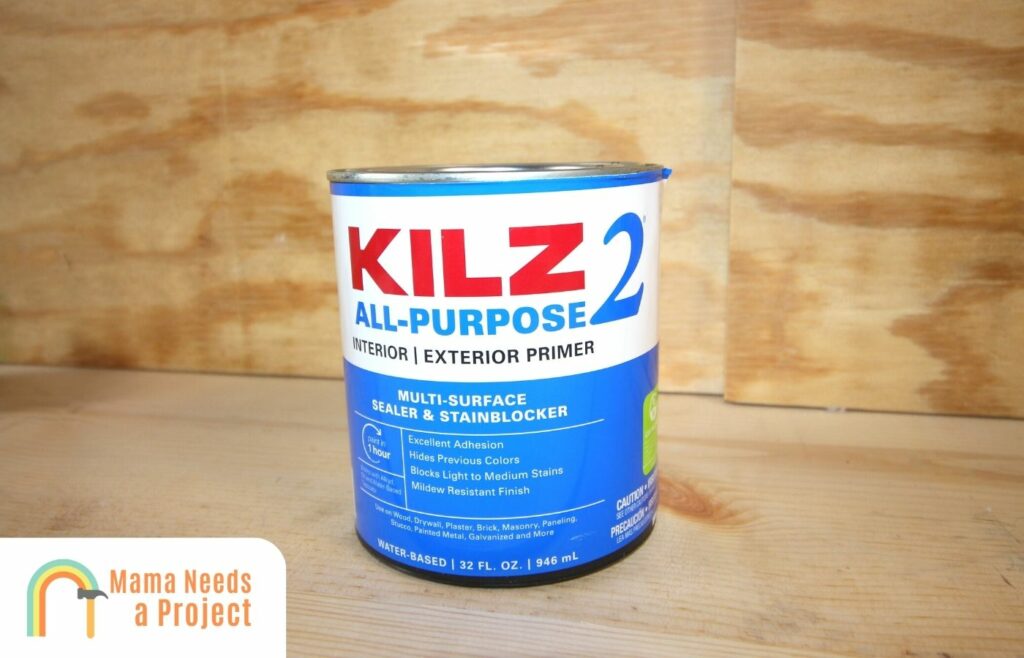
- A good primer makes paint stick better to surfaces, makes paint color truer, and lets you use less paint. KILZ…
- KILZ 2 Latex blocks mild to medium staining from water, grease, ink, pencil and felt marker and is ideal to…
- Use this versatile primer-sealer-stainblocker on interior/exterior surfaces including brick, painted metal,…
In the paint primer space, KILZ is one of the most respected brands, and KILZ 2 All Purpose Primer is one of their most popular products because it works well on all kinds of surfaces, including hundred-year-old wood.
This primer comes in a gallon can (128 fl oz) and it’s white with a matte finish.
A latex, water-based finish, it can cover 300-400 sq ft and accommodate both water-based and oil-based paints.
It can be used on exterior and interior surfaces, including wood, metal, drywall, paneling, stucco, and masonry.
When used on wood, no pre-application sanding is required.
Made with mildewcide, it prevents mold and mildew growth while ensuring an effective seal.
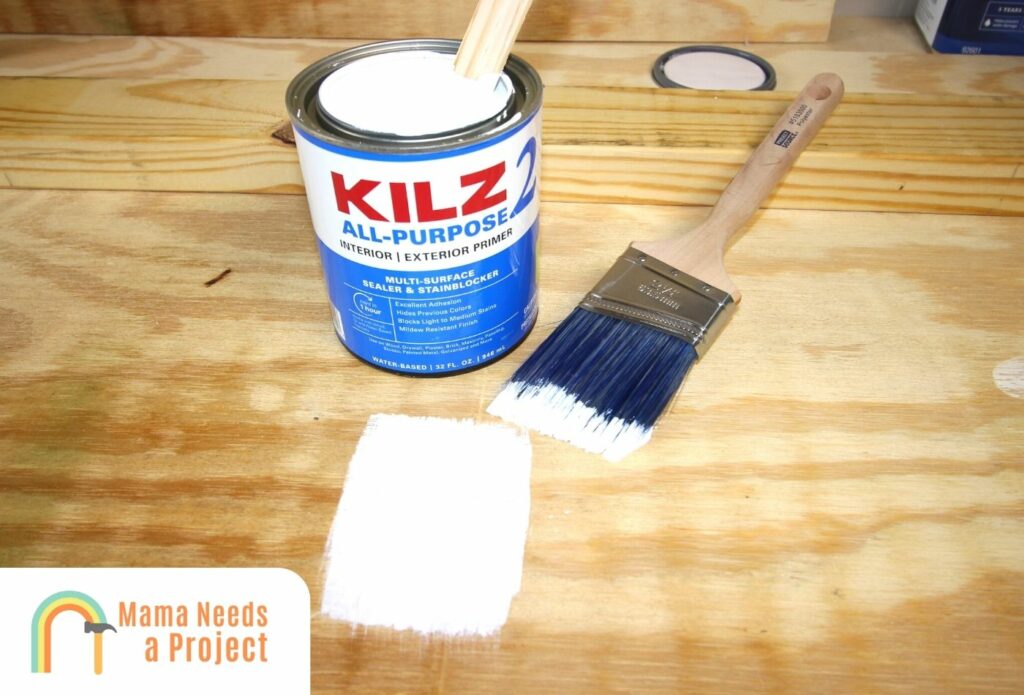
Like other latex wood primers, it can be brushed, rolled, or sprayed on, and it takes just 30 minutes to dry; 60 minutes before paint can be applied.
Finally, warm, soapy water removes it from surfaces, brushes, rollers, etc.
What I Liked:
- It adheres well to all kinds of surfaces while serving as an effective bonding agent for different paints.
- It helps with bringing out the new paint’s color since it’s a little richer than other latex primers.
- It’s perfect for antique furniture since it’s durable yet thin and easy to spread.
- It’s cheaper than some quarts of lower-quality products.
What I Didn’t Like:
- Its viscousness substantially limits its max coverage area.
- It can’t block out the odors associated with pet stains, smoke stains, etc.
My Thoughts:
Professionals and DIYers alike swear by KILZ 2 All Purpose Primer, since it can be used to great effect on a variety of interior and exterior surfaces—even antique wooden surfaces. It’s thicker than other water-based primers, and its consistency helps the topcoat’s color appear rich and vibrant. To be fair, in some ways it fails to measure up to KILZ’s Premium paint primer, but overall it’s a capable, affordable product that’s both easy-to-use and reliable. It’s also the easiest one to get your hands on.
Other Stores
5. KILZ Adhesion Exterior Primer – Best Exterior Primer for Peeling Paint
- BONDING PRIMER: A high adhesion primer that bonds to a wide range of difficult to adhere to surfaces. It is…
- ADVANCED FORMULA: It’s advanced styrenated acrylic polymer formula provides a sound anchor for topcoats while…
- MULTIPLE SURFACES: Use on most interior and exterior surfaces where a secure bond is critical. Bonds to…
KILZ Adhesion Exterior Primer is a glossy, latex primer that’s designed to promote superior adhesion, so it’s often used on surfaces that may need to withstand harsher conditions frequently.
Like all the other primers on this list, it’s white and quick-drying, but it comes in a gallon can.
After application, it’ll be dry in 30 minutes, and the first coat of paint can be applied in 60.
But if it’s being used before lacquer, epoxy, or other products that contain xylene or other hot solvents, give it at least 24 hours of drying time before applying the finish.
A gallon can of this primer can cover 75-100 sq ft, and it can be applied on a variety of surface materials with a roller, brush, or sprayer.
It’s a relatively strong finish, but it doesn’t have the components that make other primers mold- and mildew-resistant.
That said, it’s odor-blocking, a quality all the other primers can’t boast.
Finally, if purchased directly from KILZ, it comes with a lifetime limited warranty.
What I Liked:
- Effectively binds paints that are routinely exposed to high heat, deluges, and temperature fluctuations.
- Glossy finish helps accentuate the qualities of the paint that’s applied over it.
- Doesn’t just bind paints but durable finishes too, e.g. polyurethane, lacquer, and epoxy.
- Easy to spread even though it’s strong and much more viscous than other latex paint primers.
What I Didn’t Like:
- Even a gallon of this primer barely covers 100 sq ft, regardless of application method.
- Its price and limited coverage area makes it one of the most expensive primers available right now.
My Thoughts:
KILZ Adhesion Exterior Primer is one of the most durable paint primers on the market today, and it’s especially effective when used on surfaces that are exposed to the elements routinely. Basically, if ensuring adhesion between the paint, primer, and surface is your main goal, choose this primer. But since it’s such a high-quality product, it’s quite expensive, which is definitely something to consider before using it. In the end, if you’ve got the budget for it, you won’t be disappointed, for this is a reliable primer in every sense.
Other Stores
What to Consider When Choosing an Exterior Primer for Wood
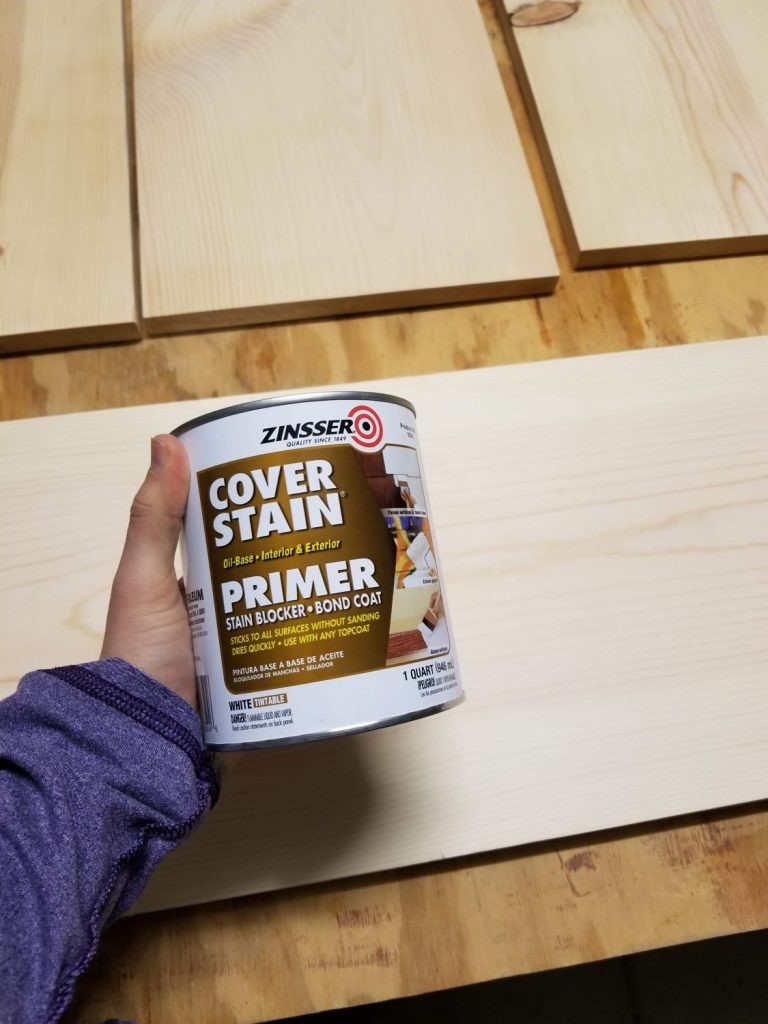
Blocking Ability
This is one of, if not the most, important factors to consider when browsing paint primers.
Even if you’re applying primer to bare wood, blocking ability is important, since even bare wood can display a range of surface imperfections.
A primer needs to be able to effectively block the color of the paint or stain underneath it, for if it can’t do this the underlying color will bleed through, mixing with the color that’s currently above the primer, leading to one big, unsightly mess.
Finally, a primer’s ability to block stains and imperfections is in large part determined by its composition, how it’s mixed ,and the way it’s applied, so make sure you take your time when mixing and applying primer.
Adhesion
A primer’s ability to adhere to surfaces, and its ability to serve as a good bonding agent for paints and finishes, are just as important as its ability to block stains and surface imperfections.
Many primers are sanding-free, meaning you don’t have to sand the coat of primer after it dries to ensure good adhesion with the paint.
Plus, primer isn’t just for bare wood or painted wood—it can be used to great effect on metal, concrete, glass, and many other materials.
Volume
Volume should be considered in relation to price.
In other words, if something is expensive, but you only get a quart of it, chances are this is a high-grade product, so think twice before you use it on a large surface, as multiple cans may be required.
On the other hand, if you get a gallon of either latex or oil-based primer, and it’s relatively low-cost, chances are it’s not of highest quality.
Volume should also be considered in relation to spreadability, but I’ll dive more into that in the next section.
Spreadability
How much coverage a can of primer gets you is incredibly important.
Most primers can deliver more than 100 sq ft of coverage, with some products being able to adequately cover hundreds of square feet.
And just because a can of primer has more capacity doesn’t mean it automatically covers more space than cans with less capacity, as the last product on this list demonstrates.
Price
As far as paint primer prices go, most of the decent stuff is between $11 and $20, with higher-quality products being between $25 and $35. The premium stuff can go for upwards of $50.
And don’t forget to consider price in relation to volume and spreadability. Depending on which primer you use, multiple cans may be required, which can get expensive.
Toxicity
Toxicity may be the last quality listed here, but don’t take this to mean it’s of little importance. You should always apply paint primer with the right protective gear, i.e. goggles, gloves, and a respirator, since primer can emit toxic fumes that are harmful to humans (if you’re over exposed).
Oil-based primers tend to have more VOC than latex primers, but that doesn’t mean you should apply latex primer without safety gear.
Types of Primer and How to Choose Which is Best for Exterior Wood
The three main kinds of paint primer are latex primer, oil-based primer, and shellac-based primer, and which is best for your project is collectively determined by numerous factors, such as the conditions the primer will be exposed to, your budget, and the size of the surface.
Latex Primer
Latex primer is what most people use before putting down paint, whether it’s on an interior or exterior surface.
While it’s not as durable as oil-based primer, it can withstand constant exposure to the elements, form an effective seal once fully cured, and be dry enough for paint in under an hour.
Latex primer is also the easiest to spray. No thinning is required beforehand and it won’t clog a sprayer midst application.
It also spreads better than oil-based primer, and it’s not nearly as toxic.
More coats are required, yes, but overall this is the best wood primer if you want quality for a fair price.
Oil-Based
Oil-based primer is more durable, offers better adhesion, and covers up stains and surface imperfections better than its latex counterpart.
It works on both porous and non-porous surfaces, but usually individuals choose latex for porous surfaces because it soaks into the pores quicker and therefore dries quicker.
Oil-based primer is also glossier, which means the paint that goes over, whether it’s latex- or oil-based, should be semi-glossy at a minimum.
Its downsides are its much longer drying time and the fact that it contains a lot of VOC. Plus it’s hard to spray, but you shouldn’t have much trouble brushing or rolling it.
Shellac-Based Primer
Shellac-based primer is a more natural option that’s good for both interior and exterior use.
It works best when applied to bare wood, but it can be applied to painted wood as well, provided the paint isn’t a rich, dark color. In other words, its stain/paint blocking ability is good but not great.
It takes about just as long to dry, but if not thoroughly mixed before being applied it may not adhere to the surface properly.
Lastly, the only notable downside is this paint binder degrades quicker than latex and oily versions.
FAQs
Should I use oil based primer or water based primer for exterior surfaces?
Provided everything goes right during the application process, you should get good results whether you use a water-based or oil-based primer. That said, oil-based primers are thicker and stronger, so they have no trouble withstanding even prolonged exposure to the elements.
Should I do one or two coats of exterior primer?
If you’re using a water-based primer, multiple coats (2-3) will be necessary, whether it’s for interior or exterior use. On the other hand, 1-2 coats of oil-based paint primer is usually enough, whether it’s a porous surface or smooth surface.
How long should exterior primer dry before painting?
Most exterior paint primers take 30-60 minutes to dry. After 30 minutes, it should feel dry, and after 60 minutes it should be dry enough for paint. If it’s an especially tough bonding primer, however, it’s best to double the drying time (2 hours) to ensure good adhesion.
How long should you wait between primer and first coat?
Usually, primer has to dry for at least an hour before it’s ready for the first coat of paint. You can accelerate the drying process by 5-10 minutes by using a heat gun or hair dryer, but this may reduce the effectiveness of the primer if you do it incorrectly, so I suggest waiting patiently for the primer to dry naturally.
Final Thoughts
To recap, the best exterior primer for wood is KILZ Premium High-Hide Interior/Exterior Primer/Sealer because it’s an easy-to-use, less-toxic product that blocks out even prominent stains and surface imperfections while ensuring a long-lasting seal, and both latex- and oil-based paints adhere to it well.
However, Zinsser Bulls Eye 1-2-3 Primer is the absolute best when it comes to blocking out stains, surface imperfections, odors, and previous finishes, and it’s not outrageously expensive despite being such a versatile and reliable product.
Finally, there’s INSL-X Prime All Primer, the best budget pick since it’s cheap, easy to use, and able to cover hundreds of square feet, whether the surface is porous or not.

